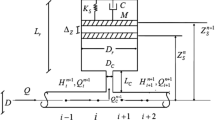Abstract
The impact of the surge tank has been incorporated into the platform of the impulse response method. The impedance functions for pipeline systems equipped with a surge tank were also derived. Hydraulic transients could be efficiently analyzed by the developed method. The simulation of normalized pressure variation using the method of characteristics and the impulse response method shows good agreement only in the condition of an identical computational interval between pipeline elements and that of the surge tank connector. The important numerical issue, the Courant number condition, of the traditional grid-based approaches can introduce substantial difficulty for optimization of surge tank parameters. The surge tank design could be performed by incorporation of the impulse response method with the Genetic Algorithm (GA). The objective functions for the surge tank design can be made using the pressure-head response at any point along the pipeline system while considering both the security and cost of the system. Substantial flexibility in the design of surge tank parameters, such as the location in the pipeline, the length of the connector, and the diameters for the connector and the surge tank can be found during the optimization procedure.
Similar content being viewed by others
References
J. A. Roberson, J. J. Cassidy and M. H. Chaudhry, Hydraulic engineering. John Wiley and Sons, Inc., N. Y. (1995).
E. B. Wylie and V. L. Streeter, Fluid transient in systems. Prentice Hall, Inc., Englewood Cliffs, N. J. (1993).
A. R. D. Thorley and P. Lastowiecki, Air vessel deign for rising mains. Proc. Int. Conf. on the Hydraulics of Pumping Stations, Manchester, U. K. 89–98. (1985).
A. R., Di Santo, U. Fratino, V. Iacobellis and A. F. Piccinni, Effects of Free Outflow in Rising Mains with Air Chamber. J. of Hydraul. Eng. 128(11) (2002) 992–1001.
T. S. Lee, A numerical method for the computation of the effects of an air vessel on the pressure surges with air entrainment. Int. J. Numer. Methods Fluids 28 (1998) 703–718.
M. H. Chaudhry, Applied Hydraulic Transients, 2 nd ed., Van Nostrand Reinhold, New York, (1987).
C. Jaeger, Contribution to stability theory of systems of surge tanks. Trans. ASME 80 (1958) 1574–1584.
C. Jaeger, A review of surge tank stability theory criteria. J. Basic Eng. ASME (1960) 765–783.
F. T. Brown, The transient response of fluid lines. J. Basic Engrg., TRANS. ASME 84(4) (1962) 547–553.
S. Kim, W. Yoo, K. Oh, I. Hwang and J. Oh, Detection of Leakage Point via Frequency Analysis of a Pipeline Flow. J. Mec, Sci. Tech. 20(3) (2006) 426–434.
L. Suo and E. B. Wylie, Impulse response method for frequency-dependent pipeline transients. J. Fluids Engrg. Trans. ASME 111(4) (1989) 478–483.
S. H. Kim, Extensive development of leak detection algorithm by impulse response method. J. Hydraul. Eng. 131(3) (2005) 2001–2007.
S. H. Kim, Impedance matrix method for transient analysis of complicated pipe networks. J. Hyarul. Res. 45(6) (2007) 818–828.
B. W. Karney and D. McInnis, Efficient calculation of transient flow in simple pipe networks. J. of Hydraul. Eng. 118(7) (1992) 1014–1030.
W. Zielke and G. Rosl, Discussion of Resonance in Pressurized Piping Systems. J. Hyd. Div., ASCE 97(HY7) (1971) 1141–1145.
S. H. Kim, Impulse response method for pipeline systems equipped with water hammer protection devices. J. of Hydraul. Eng. 143(7) (2008) 961–969.
D. E. Goldberg, Genetic Algorithms in Search, Optimization and Machine Learning, Addison-Wesley Publishing Co., Inc. (1989).
Author information
Authors and Affiliations
Corresponding author
Additional information
This paper was recommended for publication in revised form by Associate Editor Haecheon Choi
Sanhyun Kim received his Ph.D. degree in Civil and Environmental Engineering from Purdue University, West Lafayette, IN USA in 1996. He is currently a professor in the Department of Environmental Engineering in Pusan National University, Busan South Korea. Dr. Kim’s research interests are theoretical and experimental study of pipeline hydraulics and water quality dynamics, and surface and subsurface hillslope hydrological processes in unsaturated zone.
Rights and permissions
About this article
Cite this article
Kim, SH. Design of surge tank for water supply systems using the impulse response method with the GA algorithm. J Mech Sci Technol 24, 629–636 (2010). https://doi.org/10.1007/s12206-010-0108-y
Received:
Revised:
Accepted:
Published:
Issue Date:
DOI: https://doi.org/10.1007/s12206-010-0108-y




